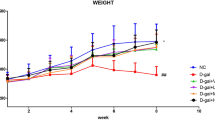Abstract
Objective
To examine the effect of Dendrobium officinale (DO) on D-galactose-induced aging mice.
Methods
Aging mice was induced by D-galactose at 0.125 g/kg for 10 weeks through subcutaneous injection except for the negative control group. After 10 days, according to complete random design, the aging modeling mice were randomized into 4 groups: aging control group (10 ML·kg-1·d-1) of distilled water), positive control group (vitamin B6 and ganodema lucidum tablets with a dose of 1 tablet/kg), DO-1 treatment group (DO juice with a dose of 1 g/kg), DO-2 treatment group (DO Polysaccharide with a dose of 0.32 g/kg), 14 mice in each group. All the animals were orally medicated daily for 9 weeks. Cognitive function assessment was performed using the maze test and step-down test. At the end of experiment, the superoxide dismutase (SOD), glutathione peroxidase (GSH-Px), and total antioxidant capacity (T-AOC) levels in the serum, the SOD, GSH-Px and nitric oxide (NO) levels in the cerebrum, the SOD and catalase (CAT) levels in the liver, the SOD and NO levels in the heart, and the SOD level in the kidney, were determined using commercial kits. The spleen, liver, heart, cerebrum and kidney were excised for histological study.
Results
Compared to aging control group, DO shortened the time of passing through the maze and prolong the step-down latency of aging mice (P <0.05 or P<0.01). DO markedly up-regulated serum levels of SOD, GSH-Px and T-AOC, and restored SOD levels in the heart, liver, kidney and cerebrum to normal status (P<0.05 or P<0.01). DO at the dose of 1 g/kg also signififi cantly improved the degree of spleen lesions (P<0.01).
Conclusions
DO had marked anti-aging effect on D-galactose-induced model of aging. The underlying mechanism could be related to modulation on antioxidation system and immune system. The results indicated that DO could potentially be used as natural drugs or functional foods for preventing aging.
Similar content being viewed by others
References
Butterfield DA, Abdul HM, Newman S, Reed T. Redox proteomics in some age-related neurodegenerative disorders or models thereof. NeuroRx 2006;3:344–357.
Forster MJ, Dubey A, Dawson KM, Stutts WA, Lal H, Sohal RS. Age-related losses of cognitive function and motor skills in mice are associated with oxidative protein damage in the brain. Proc Natl Acad Sci USA 1996;93:4765–4769.
Murali G, Panneerselvam C. Age-associated oxidative macromolecular damages in rat brain regions: role of glutathione monoester. J Gerontol A Biol Sci Med Sci 2007;62:824–830.
Govoni S, Amadio M, Battaini F, Pascale A. Senescence of the brain: focus on cognitive kinases. Curr Pharm Des 2010;16:660–671.
Mokrasch LC, Teschke EJ. Glutathione content of cultured cells and rodent brain regions: a specifi c fl uorometric assay. Anal Biochem 1984;140:506–509.
Pradhan SN. Central neurotransmitters and aging. Life Sci 1980;26:1643–1656.
Vina J, Gomez-Cabrera MC, Lloret A, Marquez R, Minana JB, Pallardo FV, et al. Free radicals in exhaustive physical exercise: mechanism of production, and protection by antioxidants. Iubmb Life 2000;50:271–277.
Taysi S, Oztasan N, Efe H, Polat MF, Gumustekin K, Siktar E, et al. Endurance training attenuates the oxidative stress due to acute exhaustive exercise in rat liver. Acta Physiol Hung 2008;95:337–347.
Ho SC, Liu JH, Wu RY. Establishment of the mimetic aging effect in mice caused by D-galactose. Biogerontology 2003;4:15–18.
Wei H, Li L, Song Q, Ai H, Chu J, Li W. Behavioural study of the D-galactose induced aging model in C57BL/6J mice. Behav Brain Res 2005;157:245–251.
Hasani-Ranjbar S, Khosravi S, Nayebi N, Larijani B, Abdollahi M. A systematic review of the effi cacy and safety of anti-aging herbs in animals and human. Asian J Animal Veterin Adv 2012;7:621–640.
Hsieh YS, Chien C, Liao SK, Liao SF, Hung WT, Yang WB, et al. Structure and bioactivity of the polysaccharides in medicinal plant Dendrobium huoshanense. Bioorg Med Chem 2008;16:6054–6068.
Luo A, He X, Zhou S, Fan Y, He T, Chun Z. In vitro antioxidant activities of a water-soluble polysaccharide derived from Dendrobium nobile Lindl. extracts. Int J Biol Macromol 2009;45:359–363.
Zhao Y, Son YO, Kim SS, Jang YS, Lee JC. Antioxidant and anti-hyperglycemic activity of polysaccharide isolated from Dendrobium chrysotoxum Lindl. J Biochem Mol Biol 2007;40:670–677.
Luo A, He X, Zhou S, Fan Y, He T. and Chun Z. In vitro antioxidant activities of a water-soluble polysaccharide derived from Dendrobium nobile Lindl. extracts. Int J Biol Macromol 2009;45:359–363.
Cui MZ, Liu H, Li CY. Preparation and evaluation of experimental rat models of aging. Chin J Compara Med (Chin) 2006;16:118–121.
Song X, Bao M, Li D, Li YM. Advanced glycation in D-galactose induced mouse aging model. Mech Ageing Dev 1999;108:239–251.
Zhu QL, Yang J, Xue Q. Comparative study of the changes in anti-oxidative ability in artifi cial and natural senile mice. Chin J Gerontol (Chin) 2003;23:448–450.
Author information
Authors and Affiliations
Corresponding author
Additional information
Supported by the Science and Technology Project Scheme of Guangdong Province (No. 2012A030100001, 2015B020234008), Guangdong Province Universities and Colleges Pearl River Scholar Funded Scheme (2011, 2012), Special Funds from Central Finance of China in Support of the Development of Local Colleges and University [No. 276(2014)] and Innovative Development of Traditional Chinese Medicine Scientific Research Team (No. A1-AFD01514A03), China, Excellent Young Teachers Program of Guangdong Province (Al- AFD 015141Z0203)
Rights and permissions
About this article
Cite this article
Liang, Cy., Liang, Ym., Liu, Hz. et al. Effect of Dendrobium officinale on D-galactose-induced aging mice. Chin. J. Integr. Med. (2017). https://doi.org/10.1007/s11655-016-2631-x
Received:
Published:
DOI: https://doi.org/10.1007/s11655-016-2631-x




